


Authors: Anton Vacharadze, Nino Gozalishvili
Editor: Levan Avalishvili
Translated by: Mariam Kalandadze
After the invasion of Ukraine, the celebration of Victory Day on May 9 has taken a special significance in the Russian Federation, as Russian propaganda seeks to adapt the narrative of victory over Nazi Germany to modern times. May 9 has always been more than a public holiday for the Soviet Union and its successor - the Russian Federation. The narrative of victory over Nazism is deeply rooted not only in Russian national identity but also in political practice. To this day, the narratives of victory almost aggressively cover up the trauma of war cruelty, casualties, and harm. Even today, along with the ongoing war in Ukraine, May 9 is associated with the end of the war for Russia or at least the big succes, no matter what it costs.
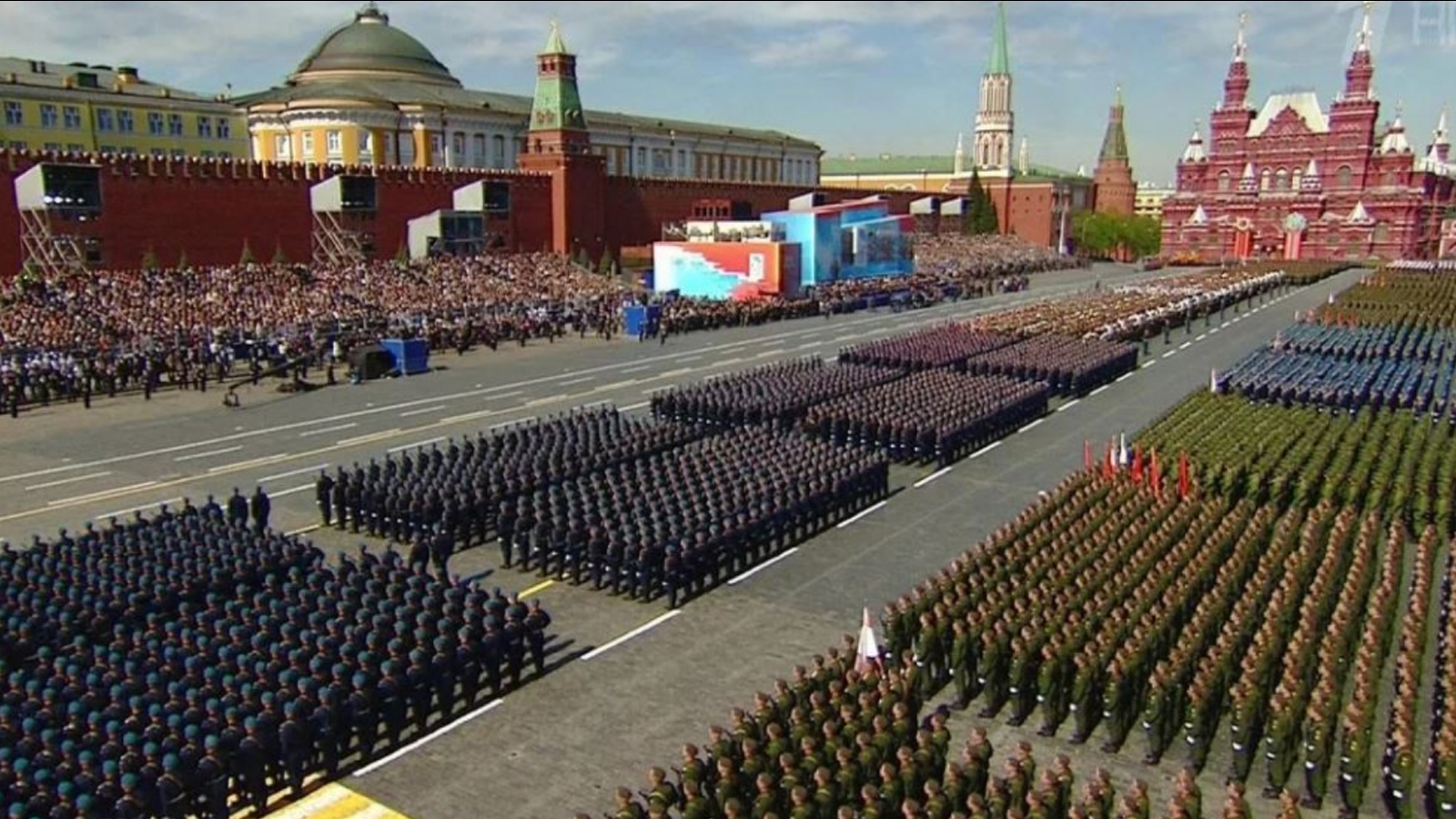
According to many Western publications, Putin was going to "successfully end" the aggressive war in Ukraine on May 9, with a grand event, the main message of which would be "defeat of Nazism." One of the important motives of the war in Ukraine is the so-called "denazification" of the country.
Vladimir Putin's first inauguration took place on May 7, 2000, and it was from this day that he took office as President. In 2008-2012, he was the Prime Minister of the Russian Federation, when he symbolically handed over the presidency to Dmitry Medvedev, and from 2012 he again became President of Russia for 2 terms. From March 2020, after he supported legislative changes in the Constitution of the Russian Federation, one of which was the initiative to "extend" the presidency, he was given the legal opportunity to remain President of Russia until 2036.
Since 2000, Putin's military rhetoric has changed over the years, and along with the symbolic and external significance of the May 9 celebrations on Red Square in Moscow.[1] In recent years, all this has been compounded by the Russian president's special attitude towards the history of Russia and neighbouring countries. As historian Fyodor Uspensky notes: "The Russian president's interest in history is fatal and harmful. This interest is alive and natural, but to satisfy interest, he obtains material from not-so-reliable sources, which often leads to tragic consequences.”
Even after a series of legislative and constitutional changes implemented by the Kremlin, presenting history in a form that contradicts the official narrative of the country is even punishable under the Criminal Code. Advocacy of contrasting narratives under the "Rehabilitation of Fascism" and other similar articles include specific punishments. This policy is clearly reflected in the new version of the Russian Constitution.
From the day he came to power, Putin and his regime began to instrumentalize Victory Day, sacralize it, and offer an even larger number of myths and legends to the public around the date. On the one hand, all this was happening with increasing militaristic activities, and on the other hand, with the establishment of one dominant narrative of the Great Patriotic War for the society, any deviation from which would be considered a rehabilitation of fascism. So for example:
- In March 2016, Sergei Mironenko, Director of the State Archives of the Russian Federation (ГАРФ), was dismissed for publishing archival documents about Panfilov Division's Twenty-Eight Guardsmen (Панфиловцы). Official documentary sources have turned the content of a propaganda film funded by the Russian Ministry of Culture into 30 million rubles upside down;
- In 2021, publicist Alexander Nevzorov was sued by the Russian Military-Historical Society for allegedly referring to World War II hero Zoya Kosmodemyanskaya as a fanatic who became a hero because of Stalin's propaganda;
- In 2021, rapper Morgenstern was forced to leave the country after he was asked in one of his interviews whether it was appropriate to spend millions on holiday events.
In addition, one of the main tools of the Putin regime is the indoctrination of schoolchildren - the introduction and formation of a system of views and stereotypes about the history of Russia and its neighbours. To this end, after the start of war in Ukraine, a special lesson "My Country" was held for students in grades 6-8 and 9th-11th across the country. According to one of the reports on the lesson: "Students were informed about why the president and the government were forced to send troops to Ukraine, not a war, but a special peace operation aimed at protecting the population of the Donetsk and Luhansk People's Republics and restraining nationalists that threatens the Russian-speaking population."
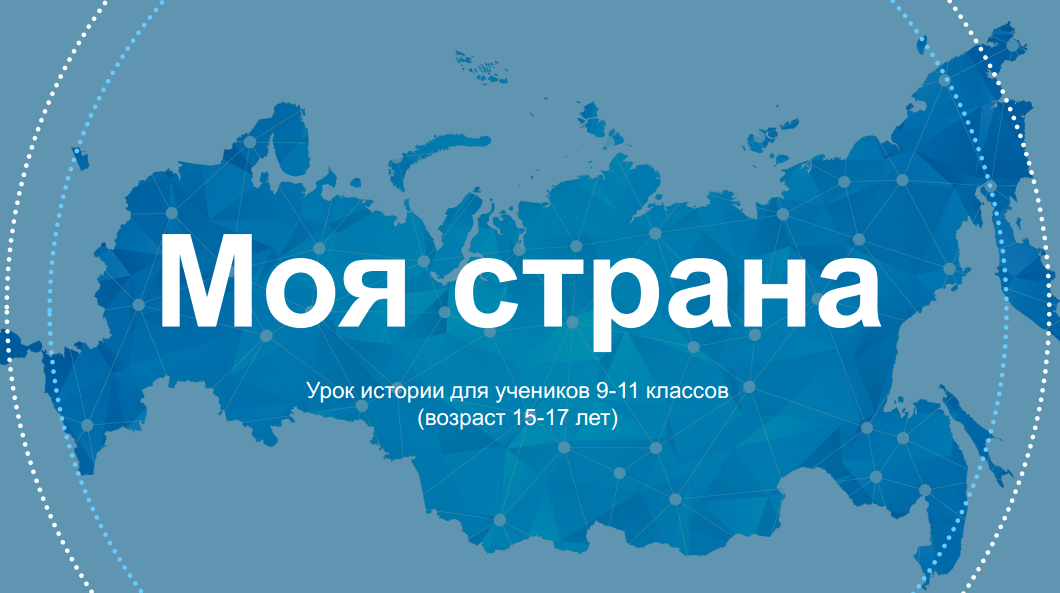
Lesson - "My Country" - Poster
The May 9 victory plays a special role in Putin's Russian national narrative: as the country has failed for years to establish the standards of Western democracy, technological and economic modernization, meet the basic needs of the population, and become increasingly corrupt, the Kremlin continues to build its narratives on defeating Nazism and 77-year-old victory.
In the current blog we will try to show how attitudes towards May 9 have changed over the years, what forms the main parade dedicated to this day took in the modern Russian Federation and which symbols or narratives dominated this day.
Before we start the discussion from 2000, we need to look at the period from Russia's independence to the end of the 1990s to clearly show the transformation that Putin's coming to power brought about in this regard. No military parades were held in 1991-1994. The 1995 parade was the first large-scale event in the history of the modern Russian Federation, as it marked the 50th anniversary of the end of the war. The parade was attended by UN Secretary General Boutros Boutros-Ghali and 56 heads of state, including US President Bill Clinton, British Prime Minister John Major, German Chancellor Helmut Kohl, Turkish Prime Minister Tansu Chiller, Ukrainian President Leonid Kuchma and Georgian President Leonid Kuchma. The parade was attended by 15,000 soldiers, as well as veterans from all 10 fronts of the Great Patriotic War, and an additional 5,000 veterans from other countries of the former Soviet Union were invited to Moscow. A parade of heavy equipment was held in Moscow, but not on the Red Square, but in the so-called "Poklonnaya Hill", because the streets around the Red Square were being reconstructed and the equipment could not move. An aviation parade was held on the same day.

Presidents of the Russian Federation and the United States, Boris Yeltsin and Bill Clinton at the 1995 parade
The 1995 parade had several significant meanings:
- Demonstration of military force, as:
1) the war in Chechnya was still going on
2) Western leaders had to see that despite the collapse of the Soviet Union, Russia's military might had disappeared;
- Winning the hearts of veterans, those Soviet citizens who suffered from the collapse of the Soviet Union, could not cope with the new economic structure and transitional social problems.
Thus, May 9, a few years after the collapse of the Soviet Union, has regained a political function that later became an important tool in Putin's policy.
In 1996, the parade was much more modest, with only 7,370 infantrymen taking part. No heavy equipment was brought to the parade. This was the last parade when the porch of the mausoleum was used as a tribune. Since then, a separate tribune has been created specifically for the day's events. The parades in 1997-1999 were also modest and did not feature much novelty or difference.
Interestingly, during the 1995 parade, an inscription - "Lenin" - on the wall of the mausoleum was covered with flowers . The inscription appeared in 1996 and was still covered in 1997-1999. The inscription on the parade has not been covered since 2000, proving once again that since Vladimir Putin came to power, Russia has again taken the path of idealising the Soviet past and has gradually become the perfect successor to the criminal regime, both ideologically and politically.
Vladimir Putin's inauguration ceremony was held on May 7, 2000. On May 8, he was already in Kursk, where he opened a memorial of a famous battle[2]. On May 9, newly elected presidents Vladimir Putin and Boris Yeltsin appeared together in the Red Square rostrum. The parade was attended by 11,000 military personnel, including 5,000 veterans from the former Soviet Union states and 6,000 active-duty military personnel from the Russian Federation. The year 2000 was the last time veterans marched on Red Square. As writer Roy Medvedev points out, the spectacle was truly impressive - the passing of a tearful people over 5,000 in their seventies, which Putin also watched with tears in his eyes. According to Roy Medvedev, the events of May 7-9 replaced the feeling of political uncertainty among the population with a sense of pride, and Putin portrayed it as the creator of it, which was quickly reflected in the statistics. For example, on May 10-12, during Putin's first 3 working days, for the first time in years, the Russian ruble strengthened against the US dollar.[3]
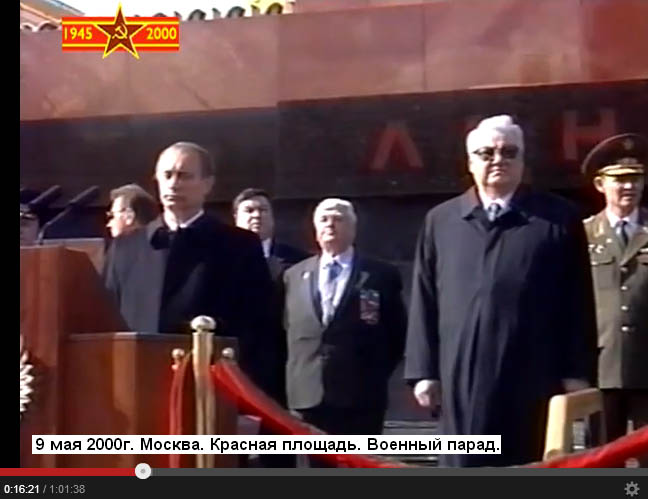
Putin and Yeltsin at the 2000 parade
The main news of 2001 was that the parade was inaugurated by the first civil defence minister in Russian history (before that the defence minister was always a military man) and a modified "Alexandrov anthem" was played for the first time. The return of the old anthem once again underscored the idea of historical continuity that Putin's policies have sought to establish since its inception.
No special news was observed at the parades in 2002-2004.
The 2005 parade was full with the theatrical elements: the veterans March was no longer held, with up to 3,000 veterans being held in state-of-the-art WWII trucks upgraded to date, and soldiers dressed in Red Army uniforms. Every unit, be it tankers or deminers with their dogs, wore WWII-era uniforms. The 2005 parade was attended by a number of Western world leaders: Bush, Hu Jintao, Jacques Chirac, Schroeder, Koizumi, and others. It is noteworthy that the above-mentioned idea of historical unity was already reflected in reality in 2005 through abstraction through theatrical elements. This year the St. George's ribbon appears (so-called Georgievsky ribbon/ Гео́ргиевская ле́нта), which became a symbol of patriotism in the Russian Federation.
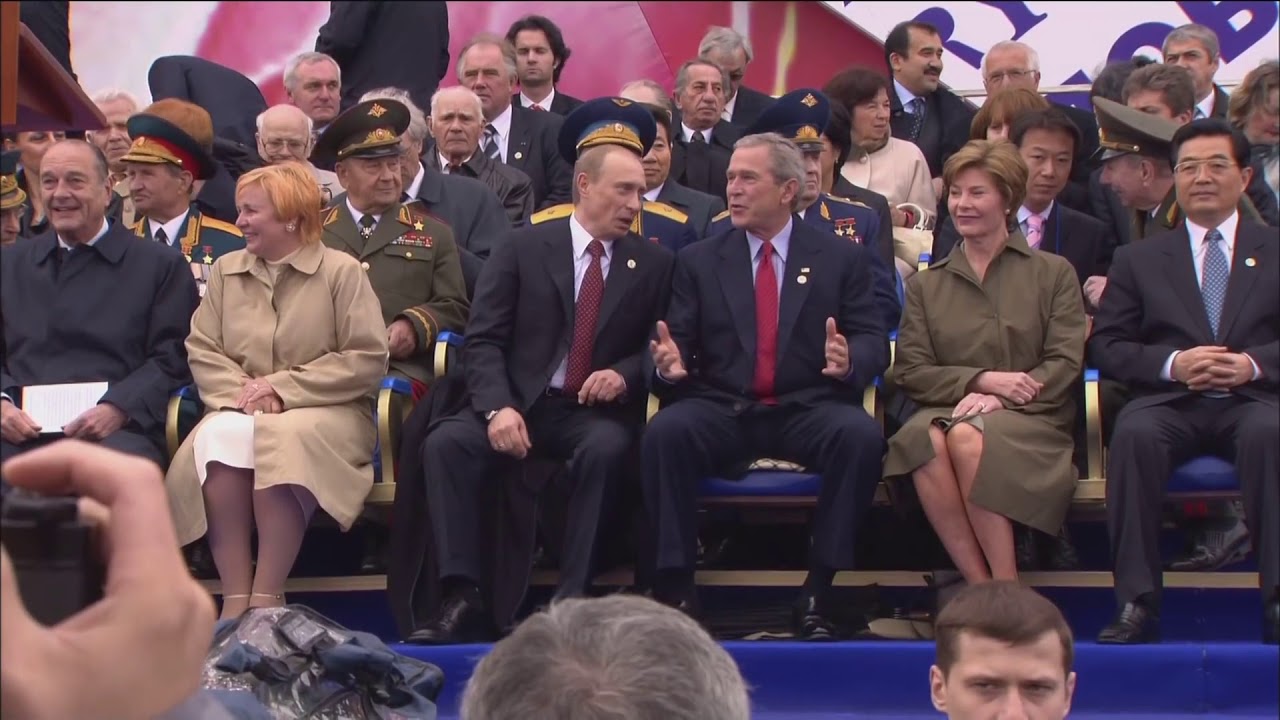
First: Jacques Chirac, Putin's ex-wife Lyudmila, Putin, George and Laura Bush, Hu Jintao - 2005 parade
In 2008, just three months after Russia invaded Georgia, the parade was pompous. It is noteworthy that the parade was preceded by the decision of the Bucharest Summit on April 3, 2008 and the commitment made by the Allies to Georgia and Ukraine to become members of NATO. Heavy military equipment was also brought to the Red Square during the parade, which is the first time in the history of the Russian Federation. Intercontinental ballistic missiles "Topol" [Тополь] were driven across the Red Square. Interestingly, intercontinental ballistic missiles were last demonstrated at parades in 1974, since the Strategic Arms Limitation Talks (SALT I) treaty was signed in 1972 between the United States and the Soviet Union. In 2008, parades were also held in 12 major cities in Russia. Concerned about the growing militarism in the Russian Federation, Putin told reporters: "We don’t play with weapons. We do not threaten anyone and do not blame ourselves for anything. It's a demonstration of our growing defence capabilities." It should be noted that this event can really be considered in the context of the concept of "demonstration of force" in international relations.
In 2009, according to official information, more than 30,000 military personnel and 10 million people took part in the parade in about 3,000 settlements in Russia. In the speech of the then President of Russia, Dmitry Medvedev, a remarkable phrase was uttered: "The descendants of war heroes will pass through this square. Among them are those who have proved in a real combat capability of the modern Russian army. We are convinced that any aggression against our citizens will be answered." It is possible that the "real clash" and the response to the aggression against the citizens meant the 2008 war against Georgia.
Despite the apparent growing militarism, the war with Georgia, and the occupation of neighbouring territories, the 2010 parade dedicated to the 65th anniversary of the end of the war was directly attended by Western democratic leaders and military units from the same countries. The armies of the anti-Hitler coalition countries: Poland, France, the United States and the United Kingdom (each sending 70 troops) marched with their own flags in support of the soldiers of the Russian Federation on Red Square. They were followed by as many military countries from post-Soviet countries: Azerbaijan, Armenia, Belarus, Kazakhstan, Kyrgyzstan, Moldova, Tajikistan, Turkmenistan and Ukraine. The parade did not pass without theatrical propaganda either. For example, a Turkmen army officer rode to the Red Square on a Akhal-Teke horse, and the propaganda claimed that it was a direct descendant of the horse with which Marshal Zhukov held a victory parade. Among those present at the parade were German Chancellor Angela Merkel, Czech President Vaclav Klaus, Estonian President Thomas Ilves, and Council of Europe Secretary General Thorbjorn Jagland. Do not support the unrecognised "President of Abkhazia" Sergei Bagapsh and the so-called "President of South Ossetia" Eduard Kokoyty. Barack Obama,Silvio Berlusconi, Nicolas Sarkozy and Gordon Brown refused to come to Moscow for various reasons. The position of the Acting President of Moldova, Mikhai Gimpu, was interesting: "I can not take part in the parade in support of the army that brought communism. This army was at the forefront of the formation of Transnistria."
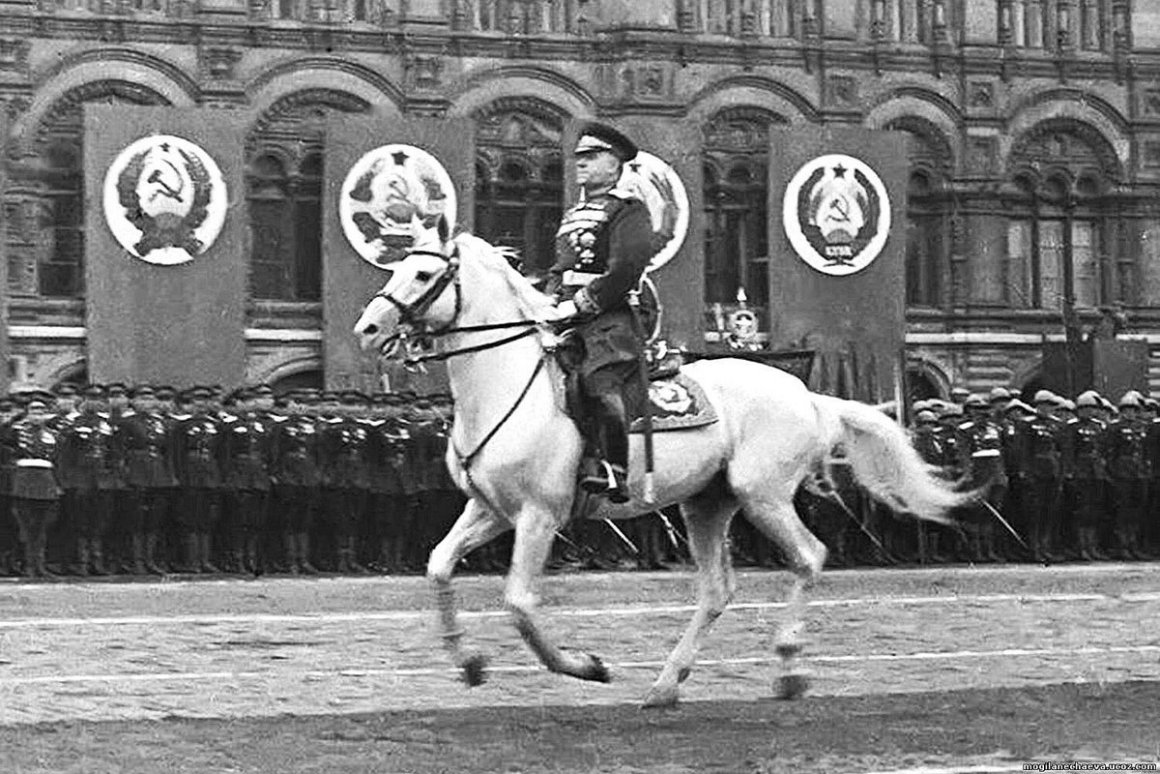
Marshall Georgiy Zhukov at the 1945 parade
Equestrian Turkmen officer at the 2010 Military Parade
A record 20,000 troops participated in the 2011 parade. Also presented a whole arsenal of equipment: armoured vehicle "“Тигр”, armoured personnel carrier БТР-80, tank T-90, self-propelled artillery unit "Мста-С", anti-aircraft missile system "Бук-М2", jet system "Смерч", anti-aircraft missile complex “Панцирь-С1”, “Искандер-М” rocket launcher and “Тополь-М” intercontinental ballistic missile complex.

Intercontinental ballistic missile complex "Topol-M"
The 2012-2013 parades were also crowded and no less than 10,000 soldiers took part in it. Heavy equipment, including intercontinental ballistic missiles, was delivered to Red Square each year.
Following the annexation of Crimea in 2014, the parade was attended by the 810th Guards Naval Infantry Brigade of the Black Sea Fleet, which led on March 18, 2014 to a new unit annexed by the Russian Federation, the so-called Flag of the "Republic of Crimea". Thus, during these years, the Russian Federation sought to bind the "new narrative" of victory to the old and thereby revitalize it, since the narrative of victory already had clearly defined socio-political functions in that period.
In 2015, at the parade dedicated to the 70th anniversary of the victory, the vector of international attendees shifted from European democracies to authoritarian countries, and the event was already attended by such odious leaders as Robert Mugabe, Raul Castro, Nicolas Maduro and others. The Minister of Foreign Affairs of the Russian Federation, Sergey Lavrov, said that the reason for the absence of European leaders in Moscow was the aggressive policy of the United States. In parallel with the parade, Putin personally participated in another propaganda campaign, organised with the support of the Russian Federation so-called "Immortal Regiment". The march was supported by 500,000 people across Moscow and 12 million across Russia.
One interesting detail was observed during the 2016 parade: as Defense Minister Sergei Shoigu was leaving the Kremlin gate in an open car, he demanded that the car be stopped, took off his hat and crossed himself. The number of international partners at the Central Tribune has shrunk even further, with Kazakh President Nursultan Nazarbayev and the last USSR leader Mikhail Gorbachev taking the lead, including singer Joseph Kobzon, American boxer Jeff Monson and director Oliver Stone, who had previously directed a four-hour documentary about Putin. In his speech, Putin referred to May 9 as not only important for the country, but also as a family holiday.
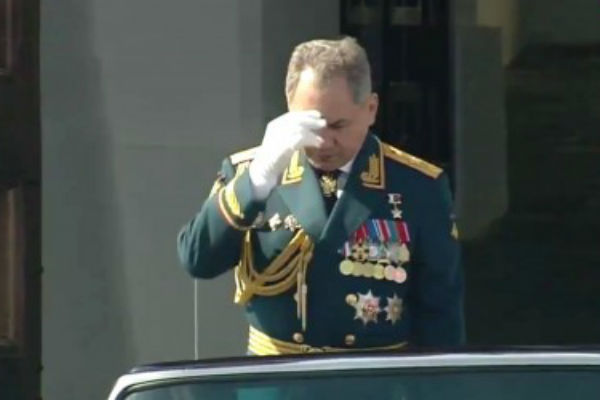
New, religious symbolism for the May 9 parade performed by Russian Defense Minister - 2016
In 2017-2019, the parade was still packed, but with less pomp. In 2020, the 75th anniversary of the victory in the Great Patriotic War due to the Covid-19 pandemic was celebrated not on May 9, but on June 24. More than 14,000 military personnel took part in the parade, as well as some of the technological innovations presented by Vladimir Putin on March 1, 2018, for example, the supersonic missile complex "Kinzhal" attached to the МиГ-31К aircraft.
Conclusion
During the 30 years of independence of the Russian Federation, the forms of the parade as well as the narratives, the number of attendees and many other aspects changed, but the political and social function that the May 9 Victory narrative has assigned remained unchanged from year to year:
- Except in 1995, during Boris Yeltsin's presidency, there was no large-scale military parade using heavy equipment and aviation. But during the Putin era, especially in the second decade, thousands of soldiers took part in the parades every year and demonstrated military equipment, which could explain the force against the West and NATO. By demonstrating and being in constant tension with the surrounding countries;
- Under Putin's regime, ideological distancing from the Soviet Union is no longer happening and, for example, one of the main symbols - the caption "Lenin" is not covered up anymore, as it was during Yeltsin’s regime, used to break the ideological chain of the Russian Federation with the Soviet past. Putin's government, on the other hand, continues to idealise the Soviet past, which is manifested in a number of symbolic acts in addition to statements made during the parade. Also noteworthy is the strengthening of religious symbolism in the modern Russian Federation - the violation of official protocol by Minister Shoigu and crossing himself before the start of the parade;
- A sense of unity with the past is the echo of nationalist policies of the Russian government: the attempt to unite around past and present victories was evident both in a number of theatrical performances and in the integration of annexed Crimea into the "Victory Narrative" after 2014. Such a solid place of May 9 in the Russian national self-consciousness can be considered as a result of such a policy;
- Leaders of the Western world have rarely been seen among official guests since 1995, for example, instead of the presidents of the United States and other leading democracies, we can see odious dictators, "presidents" of unrecognised states, and by completely incomprehensible logic - celebrities on the main podium;
- It seems that hostilities and / or international events such as the Bucharest Summit have a particular impact on the May 9 commemoration ceremony, its symbolic and political implications.
The periodic debates in Georgia regarding the change of date of the "Victory Day over Fascism" from May 9 to May 8 are noteworthy. First of all, the name of the holiday is worth mentioning - "Victory Day over Fascism" - when on this day not the Italian fascist regime, but the German Nazi "Reich" was defeated and declared capitulation. In Ukraine, for example, May 9 is "Victory Day over Nazism." In addition, it is a well-known fact that the difference between the dates in Europe and the Soviet Union was caused by the time zone - the unconditional capitulation by Germany was signed by field marschall of the Wehrmacht (name of the Nazi German Armed Forces 1935-1945) Wilhelm Kaitel. The action of the German Armed Forces in the war was officially stopped on May 8, 1945, at 23:01. It was already May 9 by Moscow time.
Due to the unprecedented instrumentalization and militaristic rhetoric of the Russian ruling elite on May 9, a number of post-Soviet countries moved the celebration of Victory Day from May 9 to May 8. In 2022, debates took place in the Parliament of Georgia as well: Opposition MPs initiated an amendment to the Labour Code of Georgia - declaring May 8 as a holiday instead of May 9. The authors of the project demanded an expedited discussion of the issue, which was not considered by the majority. During the debate, the majority appealed to arguments that did not take into account the importance of Russia's instrumentalization of May 9.
_____
[1] This blog is mainly about celebrating the main parade in Moscow, Red Square, although it should be noted that similar parades are held every year in other cities and regions.
[2] The Battle of Kursk (July 5 - August 23, 1943) was one of the largest battles between Nazi Germany and the Soviet Union, culminating in the victory of the Red Army.
[3] Рой Медведев. Время Путина. — М., 2015.

This material has been financed by the Swedish International Development Cooperation Agency, Sida. Responsibility for the content rests entirely with the creator. Sida does not necessarily share the expressed views and interpretations.